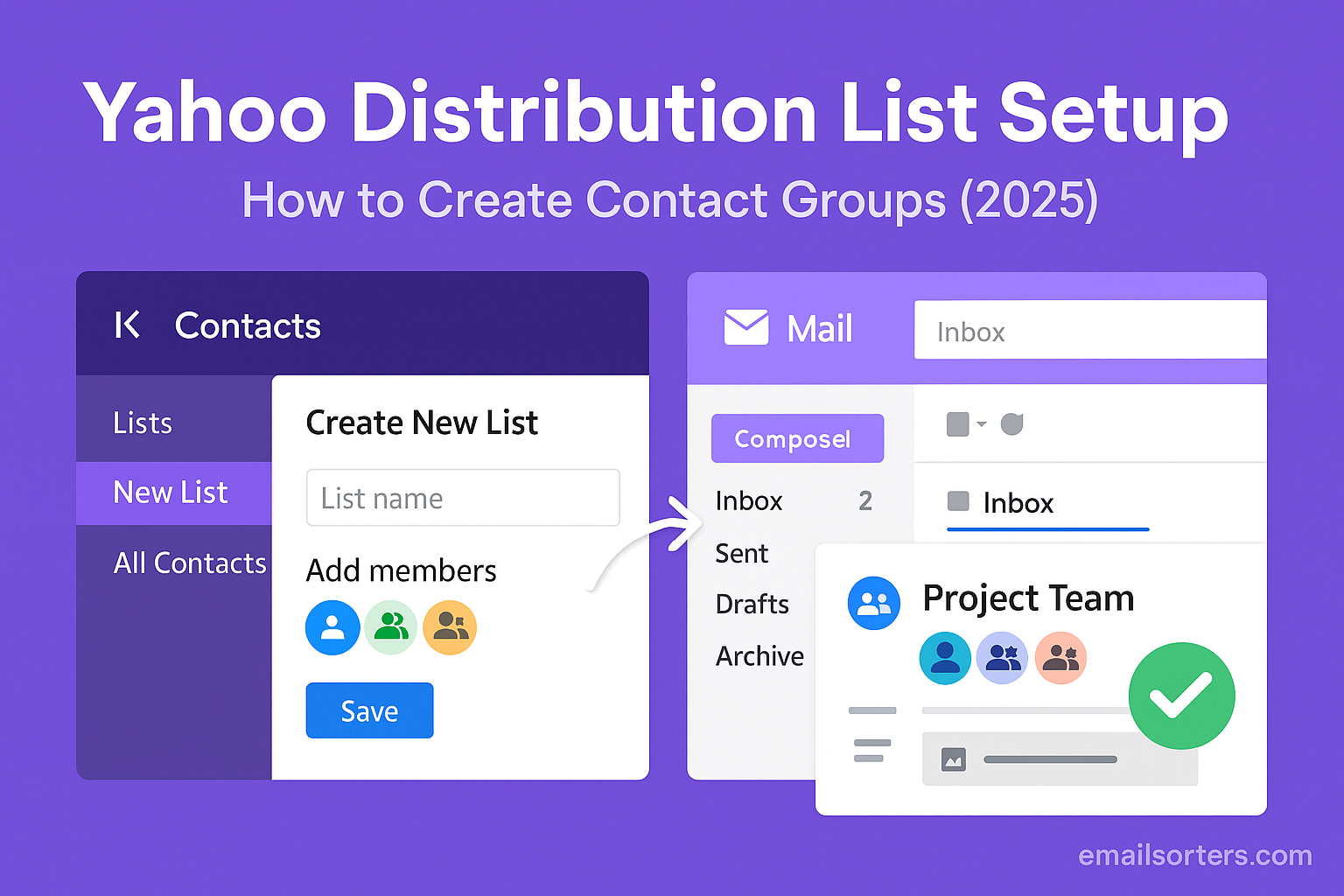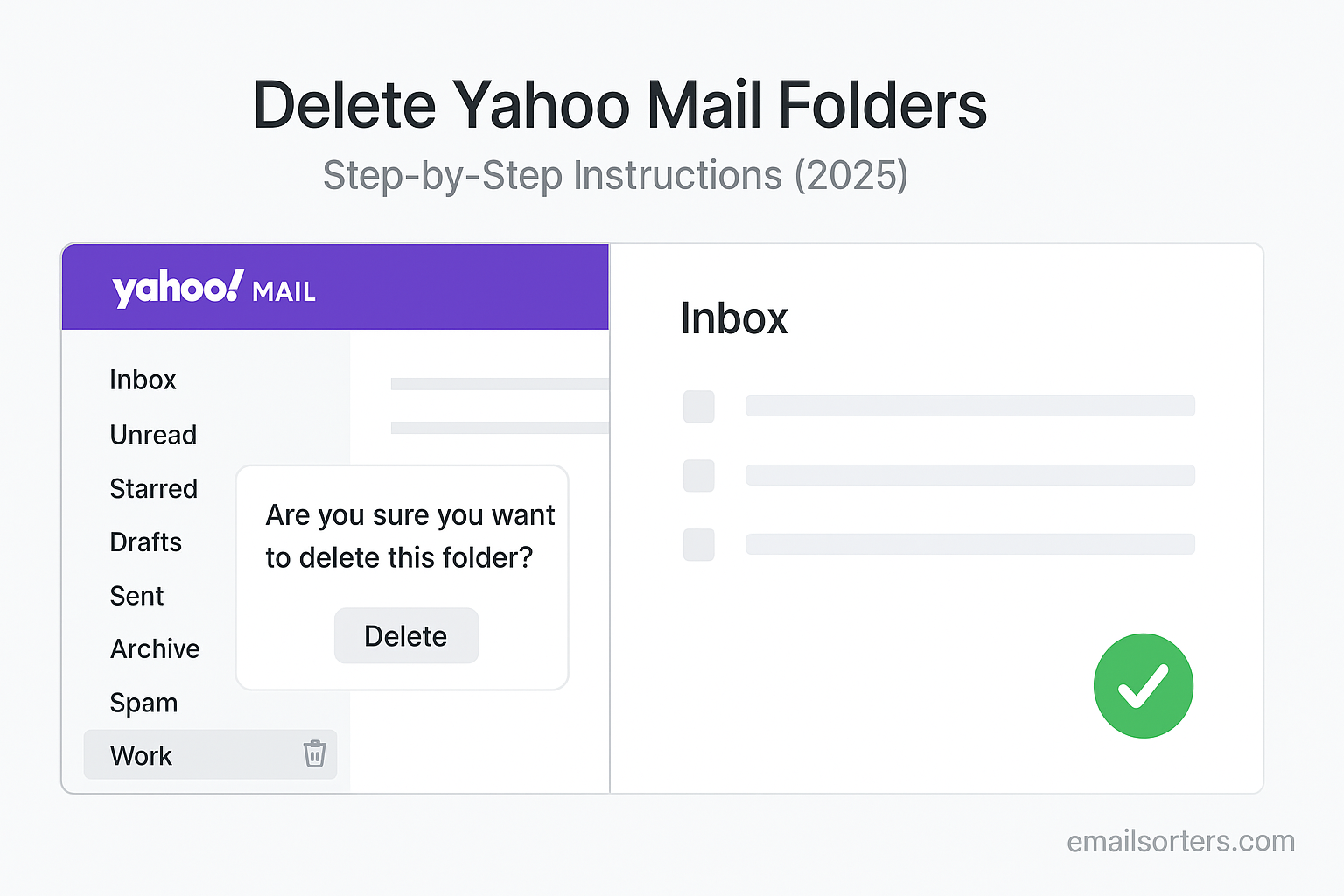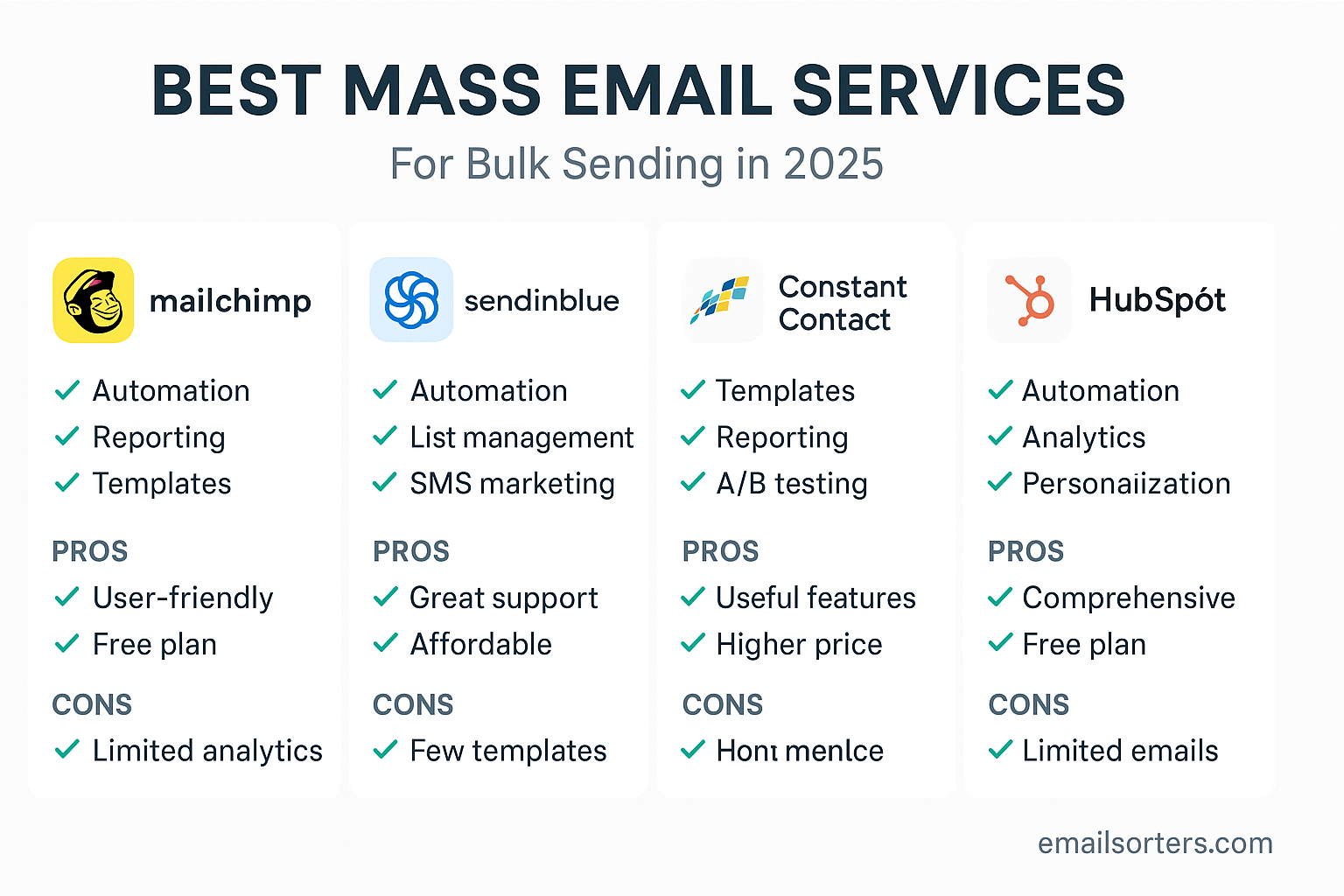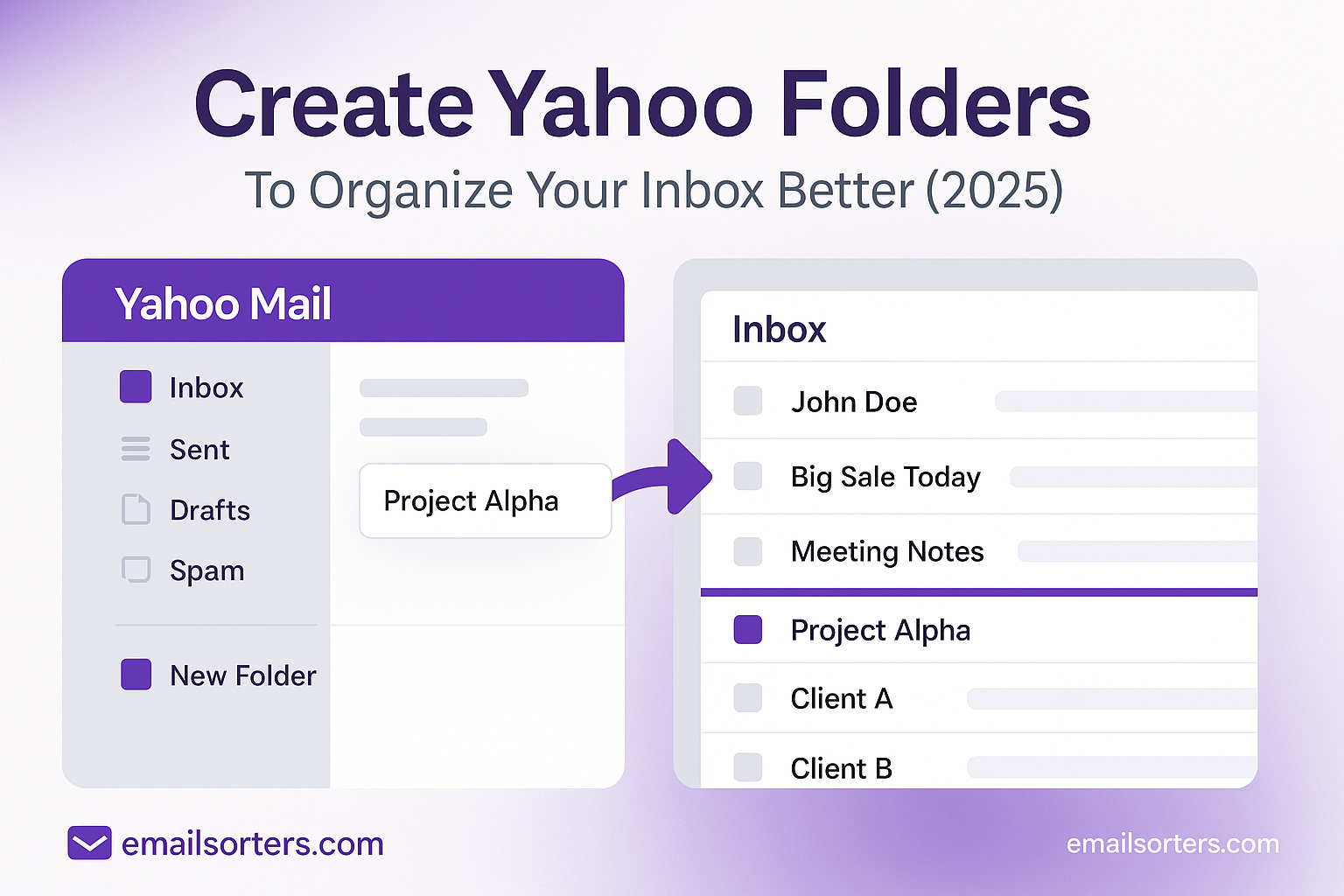Yahoo Mail distribution list is the simplest way to send one email to a whole group without typing every address each time. Think friends, family, or even a small team. You save the list once, and in just a click, everyone gets the message.
No more digging through contacts or worrying you forgot someone. With a distribution list, Yahoo Mail handles it all in one go quick, neat, and stress-free.
In an era of overflowing inboxes and scattered platforms, using Yahoo contact groups allows you to keep certain communications efficient and structured. It’s a helpful habit, especially for those who prefer familiar systems or want to avoid migrating to more complex CRM tools. And for those who use Yahoo alongside other tools, it’s a lightweight way to keep group messaging centralized.
This guide will walk you through the updated steps to set up and manage Yahoo distribution lists, offer tips for organizing your contacts, and answer common questions around sending group emails without losing personalization or privacy.
Step-by-Step Guide to Creating a Contact Group in Yahoo Mail
Setting up a distribution list in Yahoo Mail is a simple, practical task that can make your email experience much more efficient. Though Yahoo no longer refers to them directly as “distribution lists,” the functionality lives within the Contacts section of your Yahoo account. Here’s how you can set up your own contact group using the current Yahoo Mail interface.
First, log in to your Yahoo Mail account. On the right side of the screen, click the Contacts icon. It looks like a little address book and sits in the same column as the Calendar and Notepad icons. Once you click on it, your saved contacts will appear in a new panel. If you’ve never accessed this section before, it may take a moment to load.
Next, click “Lists” at the top of the Contacts panel. If you’re using the updated Yahoo interface, this may also show as “New List” or a “+” icon depending on your screen size. Give your contact group a name; something clear and specific, like “Book Club,” “PTA Members,” or “Team Project A.”
After naming your group, begin adding contacts. You can do this in a few ways. If your contacts are already saved in Yahoo, simply start typing their names or email addresses, and Yahoo will auto-suggest matches. Click each one to add it to the group. If someone isn’t in your contact list yet, you can manually type in their email and Yahoo will prompt you to add them as a new contact.
Once you’ve added everyone, Yahoo will save the list automatically. To use it, simply start composing a new email, and in the “To” field, begin typing the name of your list. Yahoo will recognize the group and populate all the addresses you’ve assigned to it.
It’s worth noting that Yahoo does not currently support sending group emails as “BCC” by default through the group name. So if privacy is important; for example, you’re emailing a group of parents or clients; you’ll need to manually copy and paste the addresses into the BCC field.
Creating a contact group takes just a few minutes but saves countless minutes over time. Whether you’re sending weekly updates, coordinating logistics, or sharing announcements, having a reliable group list ensures accuracy and ease.
Tips for Organizing and Maintaining Yahoo Contact Groups
After creating a contact group in Yahoo Mail, your next goal should be keeping it clean, relevant, and easy to manage. Groups can quickly become outdated if not maintained regularly, especially if you communicate with teams or event lists that shift over time. Luckily, Yahoo’s contact features are flexible enough to support regular updates and revisions.
One effective habit is reviewing your lists every month or quarter, depending on how often you use them. This is especially important for temporary groups, like project-based teams or seasonal event invitees. By revisiting your list, you can remove inactive addresses, update name fields, and ensure new members aren’t left out.
When adding new contacts to Yahoo, consider assigning them to a group right away. This practice saves time later and prevents you from forgetting who should be included where. If someone belongs to multiple groups; say, they’re part of your work team and your volunteer project; you can include them in more than one list without duplicating the contact.
Use clear naming conventions. Instead of vague titles like “Team 1” or “Main Group,” choose names that describe the group’s purpose, such as “Marketing Team Q3” or “Neighborhood Watch.” This will help you quickly find the list when composing a message, especially if you use Yahoo Mail often.
Yahoo doesn’t support custom fields in contact groups, but you can make your own notes in the contact’s details. For instance, you might include a short tag like “Project A Lead” or “Client 2025” in the notes section of a contact’s profile to jog your memory about their role or context.
Finally, if you’re planning a high-volume email or formal outreach campaign, Yahoo’s contact group feature is a helpful starting point; but may not be a replacement for email marketing tools. In that case, consider exporting your group and importing it into a platform better suited for large-scale campaigns.
But for everyday group messaging; whether it’s a family update, volunteer committee check-in, or casual announcement; Yahoo’s contact lists provide just the right balance of simplicity and functionality.
Best Practices for Sending Group Emails Using Yahoo Contact Lists
Once your contact groups are set up in Yahoo Mail, it’s important to follow a few best practices to ensure your group emails are effective, respectful, and clear. While Yahoo provides the basic functionality to email multiple recipients at once, how you use those tools makes a big difference in the recipient experience.
The first consideration is visibility. When you email a contact group directly, all recipients will see each other’s email addresses unless you use the BCC (blind carbon copy) field. This can be problematic if the group includes people who don’t know each other; like parents from different families, customers from different companies, or attendees of a public event. In those cases, it’s better to paste your contact group into the BCC field while putting your own email in the “To” field. This keeps everyone’s privacy intact.
Keep your subject line short but descriptive. Group emails often get skimmed quickly, especially if they’re part of a weekly update or recurring announcement. Use a subject like “Volunteer Schedule: Week of Oct 1” or “PTA Meeting Notes – September Recap” so people know what to expect before they open the message.
When writing the body of your email, keep your tone clear and conversational. Address the group as a whole (“Hi Team,” or “Hello Everyone,”) and avoid language that sounds too robotic or impersonal. If it’s a large group, avoid using individual names unless necessary; this ensures no one feels left out.
Consider formatting your message for easy readability. Use bold headings, bullet points, and line breaks to make important information easy to digest. If you’re sending an update with action items or dates, put those details near the top. Yahoo’s editor includes basic formatting tools that can help you organize your message cleanly.
Be cautious with attachments. If your email includes large files, make sure they are necessary and clearly labeled. If possible, use links to shared files hosted on cloud storage platforms instead. This reduces bounce-back errors and keeps inboxes uncluttered.
Lastly, if you’re planning to email the same group frequently, let them know the expected cadence; whether that’s weekly, monthly, or only for important updates. This builds trust and helps people stay engaged with your content.
By combining Yahoo’s contact group feature with thoughtful email habits, you’ll create a smooth, professional experience for your recipients; without needing to learn a new platform or manage a complex system.
How to Edit or Delete Yahoo Contact Groups When Things Change
Digital groups evolve. Whether someone changes their email, joins a new project, or leaves a team entirely, it’s important to keep your Yahoo contact groups up to date. Managing these changes isn’t difficult, but it does require a few specific steps to ensure your messages stay accurate and effective.
To edit a contact group, open Yahoo Mail and click on the Contacts icon. Then navigate to the “Lists” tab where your groups are displayed. Click on the name of the group you want to edit. A panel will open showing all the members currently in that list.
If you need to add someone new, simply start typing their name or email address in the input field. Yahoo will auto-suggest from your saved contacts. If the person isn’t already in your address book, Yahoo allows you to add them directly from here.
To remove a contact from the group, hover over their name and click the small “X” or delete icon that appears next to it. This only removes them from the group; not from your entire contacts list; so it’s a safe step to take if someone no longer needs to receive group messages.
In cases where you need to change the name of a group (perhaps the project has ended or the group has a new focus), click the group title and look for an “Edit” or pencil icon next to the name. Enter the new title and save the changes. Clear naming keeps your inbox organized and makes sending messages much faster.
If a contact changes their email address, you’ll need to update it in your Yahoo Contacts first. Go to the “Contacts” tab, search for the person’s name, and update their details. Once their email is updated in the main contacts list, it will reflect in all lists they belong to.
Finally, to delete a group altogether, open the list panel, click the group name, and then select the delete or trash icon. Yahoo will ask for confirmation before permanently removing the group. Remember, this action does not delete the individual contacts; only the group structure.
Regular upkeep of your contact groups ensures your communication stays clean, relevant, and efficient. It’s a small act of digital maintenance that keeps everything running smoothly in the background.
Limitations of Yahoo Mail Contact Groups and Workarounds
While Yahoo Mail does support the creation and use of contact groups, it has several limitations compared to more advanced email clients or customer relationship management (CRM) tools. Understanding these limitations upfront helps you work around them effectively and avoid frustrations when communicating with groups regularly.
One of the primary limitations is the lack of advanced group settings. For example, Yahoo does not allow conditional logic or auto-grouping based on tags, activity, or custom fields. Every group must be built manually by adding individual contacts, and each contact can only carry limited metadata like a name, email, and phone number. This means if you’re managing a complex group; like event attendees across sessions, or clients with different tiers; you’ll need to maintain those distinctions manually or outside of Yahoo.
Another limitation is that Yahoo Mail groups aren’t dynamic. That means if a contact is updated or added to your main address book, they don’t automatically get added to relevant groups based on behavior or criteria. Everything must be handled by hand, which can slow you down if you manage many lists.
Yahoo also doesn’t support group-level messaging templates or analytics. While you can reuse your own text manually or save drafts, there are no built-in features for tracking open rates, monitoring clicks, or scheduling delivery times for group messages. If you need those capabilities, you may need to explore other tools like Mailchimp or ConvertKit; especially for marketing or outreach.
Another technical consideration is deliverability. Sending emails to large contact groups via Yahoo might trigger spam filters or rate limits, especially if your message includes many recipients or attachments. Yahoo isn’t designed for high-volume sends. If you consistently send emails to more than 50–100 recipients, breaking those into smaller groups or moving to a platform built for bulk email may yield better results.
A practical workaround for many of these issues is combining Yahoo contact groups with external tools. For instance, you can export your Yahoo contacts to a CSV file and upload that list to a more advanced email service provider. This gives you the convenience of managing contacts in Yahoo while using specialized tools for outreach.
Despite its constraints, Yahoo’s contact groups remain helpful for basic, recurring group messaging needs. The key is recognizing when the native tools are enough; and when it’s time to extend your workflow with external support.
When to Use Yahoo Groups vs. a Professional Email Platform
Yahoo contact groups are a great tool for personal use or small teams, but they do have limits. If you’re trying to decide whether to stick with Yahoo or shift to a dedicated email platform, consider the nature of your communication and the needs of your recipients.
If you only email the group occasionally, and the content is relatively simple; like updates for a parent group, notifications for a community event, or newsletters for a local club; Yahoo is likely enough. It allows you to create and maintain contact lists without learning a new platform or paying for additional services. For many users, the simplicity and familiarity are exactly what they need.
But if you’re emailing people more frequently, need analytics, or want to personalize content at scale, you’ll run into Yahoo’s limits fairly quickly. For example, if you want to send one version of a message to new subscribers and a different one to long-time readers, Yahoo can’t do that. Nor can it handle automated follow-up sequences, segmentation by user behavior, or branded design templates.
Professional email platforms like Mailchimp, Constant Contact, or ConvertKit offer features that Yahoo Mail doesn’t. These include advanced design tools, scheduling options, and automated workflows. They’re especially useful for marketers, nonprofit groups, or anyone growing a subscriber list.
Another major difference is deliverability. Email marketing platforms use dedicated servers designed to avoid spam filters and improve inbox placement. Yahoo, on the other hand, has more restrictions; and large group emails may bounce, land in spam folders, or get delayed.
If you’re on the fence, consider exporting a test list from Yahoo and trying a free plan on one of those platforms. See how your email looks, how it’s received, and whether the extra features make a difference. For some users, it’s worth keeping Yahoo for casual use and using a separate tool for more serious communication efforts.
Choosing the right platform isn’t about features; it’s about fitness. If Yahoo does what you need, there’s no need to switch. But if your goals are growing, your tools should grow too.
Conclusion
Yahoo Mail may not be the newest player in the email world, but its contact group feature remains useful and accessible for managing simple group communications. Whether you’re organizing a class update, managing a small volunteer list, or staying in touch with friends and family, setting up and maintaining a contact group in Yahoo can save time and create clarity.
By following the steps outlined; creating lists, keeping them updated, practicing good email habits, and knowing Yahoo’s limitations; you’ll be able to send messages that are organized, respectful, and effective. If your needs outgrow Yahoo’s offerings, you can always explore more advanced platforms while keeping Yahoo for everyday personal communication.
The goal isn’t just sending more emails. It’s sending them with intention, accuracy, and ease. That’s where a well-maintained contact group makes all the difference.
FAQs
1. Can I create multiple contact groups in Yahoo Mail?
Yes, you can create as many contact groups as you need. Each one can include any number of contacts and can be edited or deleted at any time.
2. Are contact groups private?
Contact groups themselves are private to your account, but when you send a group email without using BCC, all recipients can see each other’s addresses. Use BCC for privacy-sensitive messages.
3. Can I import contacts into Yahoo from another service?
Yes. Yahoo Mail allows you to import contacts from other platforms like Gmail, Outlook, and CSV files. After importing, you can assign them to new or existing contact groups.
4. Is there a limit to how many contacts I can include in one group?
While Yahoo doesn’t specify a strict limit, sending emails to more than 100 contacts at once may trigger spam filters or bouncebacks. For larger sends, break your group into smaller batches or use a professional email platform.
5. Can I send attachments in a group email from Yahoo?
Yes, you can attach files to any email, including group messages. Just be mindful of file size and format to ensure deliverability.




